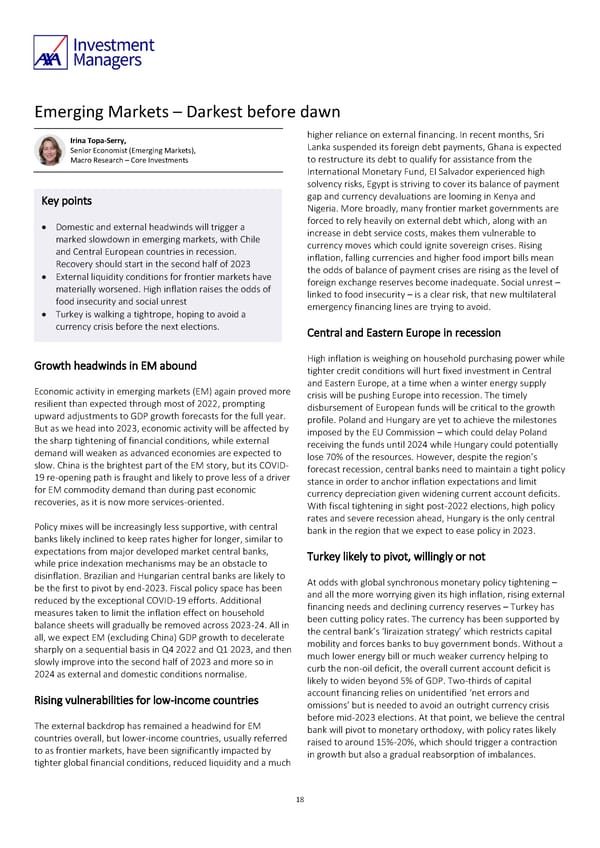Emerging Markets – Darkest before dawn Irina Topa-Serry, higher reliance on external financing. In recent months, Sri Senior Economist (Emerging Markets), Lanka suspended its foreign debt payments, Ghana is expected Macro Research – Core Investments to restructure its debt to qualify for assistance from the International Monetary Fund, El Salvador experienced high solvency risks, Egypt is striving to cover its balance of payment Key points gap and currency devaluations are looming in Kenya and Nigeria. More broadly, many frontier market governments are • Domestic and external headwinds will trigger a forced to rely heavily on external debt which, along with an marked slowdown in emerging markets, with Chile increase in debt service costs, makes them vulnerable to and Central European countries in recession. currency moves which could ignite sovereign crises. Rising Recovery should start in the second half of 2023 inflation, falling currencies and higher food import bills mean • External liquidity conditions for frontier markets have the odds of balance of payment crises are rising as the level of materially worsened. High inflation raises the odds of foreign exchange reserves become inadequate. Social unrest – food insecurity and social unrest linked to food insecurity – is a clear risk, that new multilateral • Turkey is walking a tightrope, hoping to avoid a emergency financing lines are trying to avoid. currency crisis before the next elections. Central and Eastern Europe in recession Growth headwinds in EM abound High inflation is weighing on household purchasing power while tighter credit conditions will hurt fixed investment in Central Economic activity in emerging markets (EM) again proved more and Eastern Europe, at a time when a winter energy supply resilient than expected through most of 2022, prompting crisis will be pushing Europe into recession. The timely upward adjustments to GDP growth forecasts for the full year. disbursement of European funds will be critical to the growth But as we head into 2023, economic activity will be affected by profile. Poland and Hungary are yet to achieve the milestones the sharp tightening of financial conditions, while external imposed by the EU Commission – which could delay Poland demand will weaken as advanced economies are expected to receiving the funds until 2024 while Hungary could potentially slow. China is the brightest part of the EM story, but its COVID- lose 70% of the resources. However, despite the region’s 19 re-opening path is fraught and likely to prove less of a driver forecast recession, central banks need to maintain a tight policy for EM commodity demand than during past economic stance in order to anchor inflation expectations and limit recoveries, as it is now more services-oriented. currency depreciation given widening current account deficits. With fiscal tightening in sight post-2022 elections, high policy Policy mixes will be increasingly less supportive, with central rates and severe recession ahead, Hungary is the only central banks likely inclined to keep rates higher for longer, similar to bank in the region that we expect to ease policy in 2023. expectations from major developed market central banks, while price indexation mechanisms may be an obstacle to Turkey likely to pivot, willingly or not disinflation. Brazilian and Hungarian central banks are likely to be the first to pivot by end-2023. Fiscal policy space has been At odds with global synchronous monetary policy tightening – reduced by the exceptional COVID-19 efforts. Additional and all the more worrying given its high inflation, rising external measures taken to limit the inflation effect on household financing needs and declining currency reserves – Turkey has balance sheets will gradually be removed across 2023-24. All in been cutting policy rates. The currency has been supported by all, we expect EM (excluding China) GDP growth to decelerate the central bank’s ‘liraization strategy’ which restricts capital sharply on a sequential basis in Q4 2022 and Q1 2023, and then mobility and forces banks to buy government bonds. Without a slowly improve into the second half of 2023 and more so in much lower energy bill or much weaker currency helping to 2024 as external and domestic conditions normalise. curb the non-oil deficit, the overall current account deficit is likely to widen beyond 5% of GDP. Two-thirds of capital Rising vulnerabilities for low-income countries account financing relies on unidentified ‘net errors and omissions’ but is needed to avoid an outright currency crisis The external backdrop has remained a headwind for EM before mid-2023 elections. At that point, we believe the central countries overall, but lower-income countries, usually referred bank will pivot to monetary orthodoxy, with policy rates likely to as frontier markets, have been significantly impacted by raised to around 15%-20%, which should trigger a contraction tighter global financial conditions, reduced liquidity and a much in growth but also a gradual reabsorption of imbalances. 18
 AXA IM Outlook 2023 full report Page 17 Page 19
AXA IM Outlook 2023 full report Page 17 Page 19